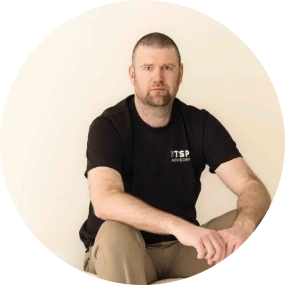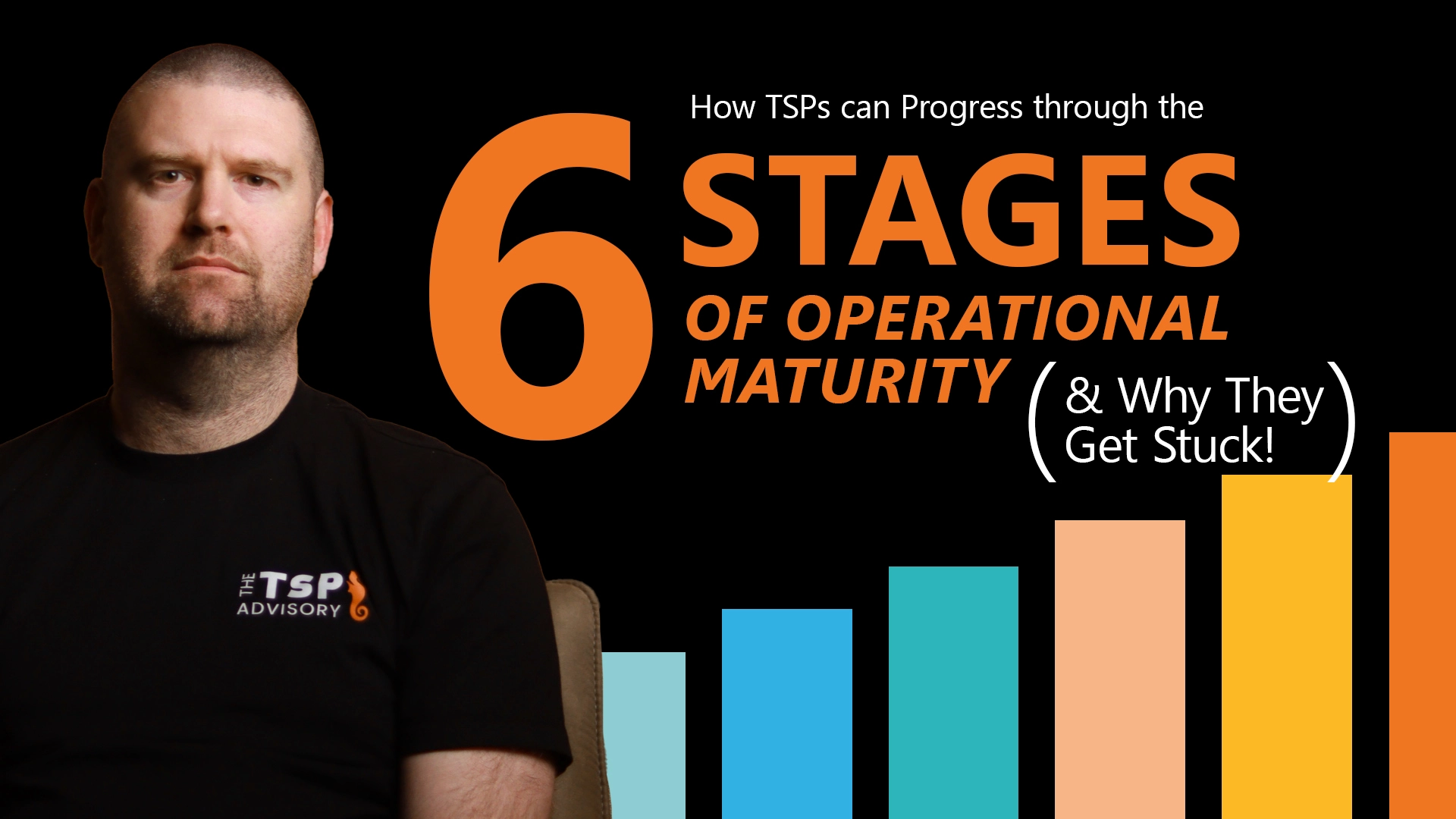Episode Summary
Join James Davis, the Founder and Chief Strategy Officer of The TSP Advisor as he breaks down the Technology Solutions Partner (TSP) concept to help technology services businesses to articulate their vision for the future and focus on the transformation activity that makes the most sense for them to meet their modern client's needs.
Transcript
James: So, technology solutions partner, it's a concept I came up with a few years ago because I was talking to a bunch of partners about the changes in the wide world of our industry and client needs evolving. And the terminology we've typically been using just wasn't appropriate. So, you think about the term MSP, it's got so many connotations, and it's used so poorly by the industry. Our clients don't know what MSP means. Vendors and disties (distributors) are using it as a ubiquitous term for partner, but we all know what an MSP is. It's managed service provider. It's a business that's focused on end user support and infrastructure management at its core. That business model then drives how we operate / operated, how we build, we engage with clients. When you start extending that out to some other business models, SI, Systems Integrator, they're focused on a technology speciality that is professional services driven compared to a VAR, a value-added reseller, who's a product driven business that may sell some services on top of selling their products.
Neither of them are MSPs, but the industry has been driving this name for so long that I've come across so many people that want to become an MSP. But as soon as I tell them what it actually entails, they run away because really what they're talking about, what they mean and what they actually want is annuity based recurring services. That's what everyone in the industry is excited about. But those services are different depending on what where you're coming from, what you're delivering, what you're providing, et cetera, different business models can provide different recurring services and make that recurring margins. And so, if I go back to all these conversations I've been having, it's been the next generation people that would normally come up through that MSP space, they know that the traditional services are commoditising. They don't feel like the old school model that everyone talks about is actually appropriate for the future. Those VARs know that they need to modernise for the cloud world. The technology categories are broadening for their clients. They need to be able to do more. And the SIs are realising they're hitting a ceiling with their speciality and the traditional MSPs are getting in their way. So, everyone's looking for this new thing. They can feel it and sense it. And so, years ago, I came up with the technology solutions partner, terminology, TSP. And the reason why I call it that is for a few reasons. So, technology is fairly obvious. If we only limit it to IT, like some people do, then we're cutting out communications.
If we're going, if we're only focused on cyber, then we're ignoring a bunch of other parts. So, technology is that holistic vision, pretty much thinking that businesses have all these technology needs, and they need partners to help them through their journey. And I'll talk more about that, but next part is the solutions as opposed to services. Services are very transactional. Their what cleaners provide, that what an electricity company provides is very commoditised. There's not a lot to it. It's very standardised. When we look at what our clients need, they're looking for solutions, looking for solutions to their business problems and creating opportunities for them to grow. They want us to help us, help them understand their risks. Help them understand opportunities to become more efficient and understand how to leverage technology to scale their businesses. You don't do that through low level services. You do that through understanding the client and providing real solutions to them. On top of that, the final part, the partners rather than a provider. Again, providers are very transactional. Electricity companies are providers. Do they have any kind of relationship with their customers? No, they just bill and charge and there's no value add, there's white glove service. Where all of us in the SMB space are very much about that relationship, that deep understanding, that white glove service. What they're looking for is that partnership. We all value partnerships.
So why not embrace that mentality and elevate our thinking into partners, whether it's partnering with our clients traditionally and elevating ourselves up to that strategic partner that's actually going to help their business or it's partner to partner play. I might be that person that's owning the relationship with small business clients and I'm leveraging technology specialists to deliver in their capability areas. That partnership idea is not just airy-fairy. It's, it's actually what we want. And this naming convention It's very important. This is, there's a lot of deep meaning behind, behind this and, and everyone I talked to that's looking at this next, next decade ahead, that they're sensing that something's different. It's been able to give them something to engage with. It's creating a purpose and a direction. That's not that typical generic advice that's coming out. It's not, it's not MSP 3 / 3.0. It's not just a bolt-on to what we've always done. What was successful in the past isn't what's gonna make us a success in the future. We need to start with breaking down that mindset. So, this is a term that I don't care what people end up calling themselves. It's just a guiding light. And in that guiding light, it's not just a one-size-fits-all. You're not just this TSP and everyone's the same. It's just not generic. We all know there's nuance.
We all know there's different business models. And so, the next level down, I created four key sort of business models that are attractive to different kinds of partners. And let's explore a few:
The first is the technology broker. And you could almost summarise this as the modern bar. It's someone that's engaged with clients that are needing a procurement partner to not just procure them hardware like an old school VA and wrap some services around that but be able to procure hardware, able to procure SaaS and cloud solutions, communications right through to services from other partners it's that conduit much like an insurance broker to all these different options and all these different specialists they've got one relationship with one person that's going out and getting the best of breed solutions for them and able to bring proactive guidance and direction to a client without having to do all the delivery.
The next one is the Boutique. And the Boutique is an advisory led organisation. It's starting from sort of business consulting, business advisory level engagements. And then providing governance, compliance, and implementations of different technologies to suit their particular clients. That's a very deep relationship led by very deep business understanding.
The next one is our technology specialist. They've got their deep expertise in a certain technology category. They've got high level resources, can provide ongoing services, they can provide project work, et cetera. But instead of the traditional SI that's very direct business focused, let's hit that ceiling. They're the ones that are building a channel model. They're going for the partner-to-partner play to amplify their efforts and realise that they're not the relationship holders, but they play a very important part in delivering technology solutions to different businesses.
The last ones are Scaled. They're pretty much what the big MSPs are doing in terms of consolidation of acquisitions, market expansion. What they're focused on is providing generic solutions and I don't mean generic in a bad way. I mean they're creating standardised solutions that can be delivered at a very cost-effective rate through automation, through offshoring, through different methods to deliver a cost-effective offering to clients. There's plenty of clients out there that don't want the White Glove service, they don't need it, they just need specific things delivered to them, specific solutions that they can afford and scale as that commoditisation of our traditional offerings are happening. These are the players that are going to take that market share because a lot of the stuff can be delivered a lot cheaper. So, when we're comparing apples to oranges or even apples to apples, the clients are going to take those cheaper offerings than what we're doing at the moment because we're not adding that value.
And so, when we start to split those four out, there's going to be overlap for particular clients. There's going to be overlap for particular types of partner businesses, you're not going to necessarily fit into one thing at a time. You might start somewhere and then realise you're something else. Those sort of four business models are a great starting point to go out, where am I aiming for? What do I need to put in place in terms of all design? What's my core drivers financially? What sort of partners do I need in my ecosystem to be more successful? And you can start to see that transformation journey actually start to have a roadmap and that's been missing in the industry for so long. And that's, that's why I created this concept and then again, at the end of the day, I ain't care what you end up calling yourself. You might call yourself a technology partner. You might be a technology procurement partner. You might just be ITC partner. You might, you just might end up calling yourself the IT guy, but you're leveraging this. You might be an advisory, whatever, doesn't actually matter, need to work out your ideal clients and what matters to them and talk to their language. This model is really just a framework guiding light for the industry to set a direction and transform from our traditional business models, which we all know are tanking into that new modern technology services-based business that can grow into the future.
I hope this sort of explanation gets the juices flowing initially and there's a lot more that we can explore in the future but just stop and think and reflect on who you are now, where you want to be in the future. And if you don't want to be one of those, I'm not saying that you're going to die, but a lot of these business models are shrinking, the margins are reducing, they're not going to be super attractive in the future.
You just need to be deliberate about that decision around whether you're going to exit in the short term or whether you need to transform for the future. Because staying the same, I don't know if I'd want to do that.
We know there's businesses out there that have come from traditional models. There's the old computer shops, there's the break fix sort of technology companies. They're still around, 99% of them are surviving, they're not making profit. They're just chugging along year to year until a to the owner finally retires and it's not a very well-paid job. It's not growing so you've got to make this deliberate decision on what you want to do and utilise what you can to make the decisions for your company's identity and what you're trying to achieve and what your current capabilities are compared to what you need to develop in the future.

Chief Strategy Officer,
The TSP Advisory

Subscribe for more
Subscribe to our resources to make sure you're in the know and for tools to enable your transformation.
